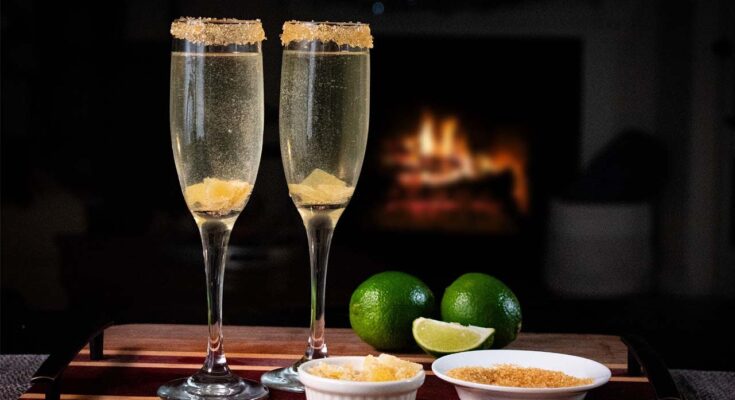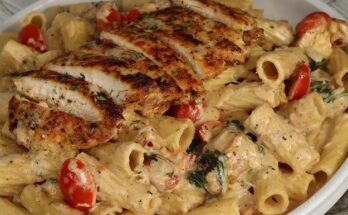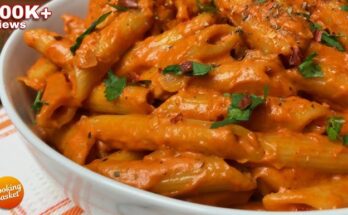Champagne Cocktail Recipe: Few drinks in the world capture elegance, celebration, and timeless charm like the champagne cocktail. Whether you’re hosting a dinner party, celebrating a milestone, or simply wanting to add a touch of sophistication to your evening, this cocktail is a perfect choice. Known for its crisp bubbles, subtle sweetness, and aromatic twist, the champagne cocktail has remained a classic since the 19th century.
In this guide, we’ll walk you through everything you need to know—from ingredients to step-by-step preparation—so you can craft the perfect glass at home.
Introduction to the Classic Champagne Cocktail
The champagne cocktail is one of those drinks that never goes out of fashion. Originating in the mid-1800s, it quickly became a symbol of luxury and refined taste. Unlike many cocktails loaded with complex spirits, the champagne cocktail relies on simplicity: champagne, sugar, bitters, and a lemon or orange garnish. Yet this simplicity is what makes it shine—it’s refreshing, crisp, and easy to prepare.
What makes the champagne cocktail truly special is its balance. The sugar cube provides just the right amount of sweetness, the bitters add a layer of aromatic complexity, and the champagne itself delivers lightness and sparkle. When served in a tall, elegant flute, it becomes more than just a drink—it’s an experience.
Over the decades, this cocktail has graced grand banquets, royal celebrations, and intimate dinner parties. Its timeless appeal lies in the fact that it’s not overly fussy. With just a handful of ingredients and a little care, anyone can prepare it. Whether you’re a seasoned mixologist or a beginner experimenting at home, the champagne cocktail is approachable yet sophisticated.
Think of it as the little black dress of cocktails: simple, versatile, and always elegant. It works just as well on New Year’s Eve as it does on a quiet romantic night in. No wonder it has remained a favorite for generations.
Ingredients You’ll Need
Before diving into the preparation, let’s gather everything you’ll need. One of the best parts about this cocktail is its short ingredient list. Yet, each item plays a crucial role in shaping the flavor and presentation.
Classic Ingredients for a Champagne Cocktail:
- 1 sugar cube – The base of sweetness that melts slowly into the drink.
- Angostura bitters – Just a few dashes to add depth and balance.
- Champagne – The star of the cocktail; crisp, dry, and bubbly.
- Lemon or orange twist – For garnish and a burst of citrus aroma.
Choosing the Right Champagne
When making this cocktail, the champagne itself matters. Ideally, go for a Brut champagne because it’s dry and balances well with the sweetness from the sugar cube. A sweeter champagne might overpower the drink. If real champagne feels out of budget, a good sparkling wine like Cava from Spain or Prosecco from Italy works wonderfully.
Essential Garnishes and Flavor Enhancers
The garnish may seem like a small detail, but it elevates the cocktail. A fresh lemon or orange twist not only looks beautiful but also releases oils that perfume each sip. Some variations also add a splash of cognac for richness or a cherry for a sweet, colorful touch.
The best part? These are all everyday ingredients. With just a quick trip to the store, you’ll have everything you need to impress your guests—or yourself.
Tools and Glassware for the Perfect Cocktail
Even the simplest recipes deserve the right tools and presentation. When it comes to champagne cocktails, glassware is especially important because it affects both the look and the drinking experience.
The Best Glassware for Champagne Cocktails
Traditionally, a champagne flute is the go-to choice. Its tall, narrow shape preserves the bubbles and showcases the golden sparkle beautifully. Alternatively, some prefer a champagne coupe for its vintage charm, though it doesn’t hold the fizz as long. If you’re aiming for elegance and tradition, stick with the flute.
Cocktail-Making Tools You Should Have on Hand
- Bar spoon – For gently stirring, if needed.
- Citrus peeler – To create a neat lemon or orange twist garnish.
- Bitters bottle/dropper – Essential for precise dashes of bitters.
That’s it! You don’t need a shaker, strainer, or fancy equipment. The beauty of the champagne cocktail is its simplicity. A good bottle of champagne, a sugar cube, and a flute are all you need to get started.
Step-by-Step Guide to Making a Champagne Cocktail
Now that we’ve covered the ingredients and tools, let’s move on to the fun part—actually making the cocktail. Follow this simple step-by-step method, and you’ll be pouring like a pro in no time.
Step 1: Prepare the Glass
Start with a clean, chilled champagne flute. Chilling helps preserve the bubbles and keeps the drink refreshing. If you have time, place your glasses in the freezer for 15–20 minutes before serving.
Step 2: Add the Sugar Cube
Drop one sugar cube into the bottom of the flute. This will act as the foundation of your cocktail, slowly dissolving as you sip.
Step 3: Infuse with Bitters
Soak the sugar cube with 2–3 dashes of Angostura bitters. The bitters bring out herbal and spicy notes that balance the sweetness. As the champagne pours in, the bitters spread throughout the drink, adding depth.
Step 4: Pour the Champagne
Gently pour chilled champagne into the glass. Hold the bottle at a slight angle and let the bubbles rise naturally. Fill the flute almost to the top, leaving just enough room for garnish.
Step 5: Garnish and Serve
Finish with a twist of lemon or orange peel. Express the oils by twisting the peel gently over the glass, then drop it in or rest it on the rim. Now, your champagne cocktail is ready to serve. Elegant, crisp, and absolutely delicious.
Variations of the Champagne Cocktail
One of the best things about the champagne cocktail is its versatility. While the classic recipe is timeless, you can easily experiment with flavors to suit the occasion or your personal taste. Here are some exciting variations you can try at home.
Classic Twist with Cognac
Want to give your champagne cocktail a richer, more luxurious flavor? Add a splash of cognac before topping with champagne. The cognac deepens the flavor, giving it warmth and complexity. This variation is perfect for winter gatherings or when you want to serve something that feels indulgent and bold.
Fruit-Inspired Champagne Cocktails
If you enjoy fruity flavors, you can substitute the sugar cube with fruit liqueurs. For example:
- Kir Royale – Swap the sugar cube for a splash of crème de cassis (blackcurrant liqueur).
- Peach Bellini – Replace bitters with fresh peach purée for a sweet, summery twist.
- Strawberry Champagne Cocktail – Add muddled strawberries and a hint of simple syrup for a vibrant pink drink.
Each variation enhances the champagne’s sparkle with fruity, refreshing notes that are great for spring and summer celebrations.
Seasonal Champagne Cocktails
You can also adapt the cocktail to the season:
- Holiday Version – Garnish with cranberries and a sprig of rosemary for a festive look and flavor.
- Spring Freshness – Add elderflower liqueur or fresh herbs like mint for a floral touch.
- Autumn Warmth – Drop in a cinnamon stick or a dash of apple brandy for cozy fall vibes.
These small tweaks make the cocktail versatile and adaptable for any celebration throughout the year.
Tips for Serving and Enjoying Champagne Cocktails
Making a champagne cocktail is one thing; serving it properly is another. The way you present and serve the drink has a huge impact on the overall experience. Here are some expert tips to help you get it right.
Perfect Serving Temperature
Champagne tastes best when chilled to 45–48°F (7–9°C). Too cold, and you’ll mute its flavors; too warm, and you’ll lose the crisp freshness. Always chill the bottle for at least three hours in the fridge or 30 minutes in an ice bucket before serving.
Best Food Pairings
Champagne cocktails pair beautifully with a wide range of foods. Try serving them with:
- Light appetizers like smoked salmon, shrimp cocktail, or oysters.
- Cheese platters featuring brie, camembert, or goat cheese.
- Sweet treats like macarons, fruit tarts, or chocolate truffles.
The bubbles and acidity in champagne cut through richness, making it a versatile pairing choice.
When to Serve Champagne Cocktails
This cocktail is perfect for:
- New Year’s Eve celebrations
- Weddings and anniversaries
- Dinner parties and holiday gatherings
- Romantic evenings for two
It’s a drink that fits any special moment. Whenever you want to add sparkle and sophistication, champagne cocktails deliver.
Common Mistakes to Avoid
Even though the champagne cocktail is simple, there are a few pitfalls to avoid if you want the best results.
Overpouring Champagne
Filling the glass too quickly or too full can cause the drink to overflow or lose carbonation too fast. Always pour slowly at an angle to maintain the bubbles.
Using the Wrong Type of Sugar
Granulated sugar dissolves too quickly and won’t create the same slow-release sweetness as a cube. Stick with a traditional sugar cube for the best texture and presentation.
Skipping the Garnish
It might seem optional, but the lemon or orange twist is crucial. It adds a burst of aroma that balances the drink. Skipping it can leave your cocktail tasting flat.
Using Sweet Champagne
Avoid overly sweet champagne (like Demi-Sec) because it will make the drink cloying. Dry, crisp champagne (Brut) is the ideal choice.
By avoiding these common mistakes, you’ll ensure your champagne cocktails are consistently elegant and enjoyable.
Health and Nutritional Insights
If you’re wondering about the nutritional side of champagne cocktails, here’s what you should know.
Calories in a Champagne Cocktail
A standard champagne cocktail contains around 120–150 calories per serving. Most of the calories come from the champagne and the sugar cube. Compared to many other cocktails, it’s actually on the lighter side.
Health Considerations
- Low in sugar compared to many mixed drinks.
- Contains antioxidants from champagne in moderate amounts.
- Still, it’s important to enjoy responsibly. Overindulgence can lead to dehydration, hangovers, or worse health effects.
Moderation is key. One or two champagne cocktails are enough to enjoy the sparkle without overdoing it.
Pairing Champagne Cocktails with Occasions
One of the reasons champagne cocktails remain so beloved is their incredible versatility. They’re not limited to one type of celebration—they shine across a wide range of events, big or small. Knowing when and how to serve them can help elevate your hosting skills and make every occasion sparkle.
Weddings and Anniversaries
Few drinks say “celebration” like champagne. A champagne cocktail adds a layer of elegance to weddings, anniversaries, or vow renewals. Imagine the first toast as newlyweds, glasses filled not with plain champagne, but with a beautifully garnished champagne cocktail—it’s a memorable touch that guests will appreciate. Plus, the bitters and sugar soften the sharpness of champagne, making it more approachable for guests who might not usually drink sparkling wine.
Holiday Celebrations
From Christmas to New Year’s Eve, the champagne cocktail is a festive must-have. Its golden bubbles and citrusy aroma pair beautifully with traditional holiday foods, while variations with cranberries, rosemary, or cinnamon fit right into the seasonal vibe. Serving them as a welcome drink sets a joyful tone for the entire evening.
Romantic Dinners
If you’re planning a date night or anniversary dinner at home, champagne cocktails add an intimate, romantic touch. The delicate bubbles, subtle sweetness, and aromatic garnish make it feel special without being heavy. Pair it with light seafood, pasta, or even dessert to impress your partner effortlessly.
Casual Gatherings
You don’t need a grand event to serve champagne cocktails. They’re perfect for brunches, garden parties, or even a casual weekend with friends. Opt for fruit-based variations like peach Bellinis or strawberry champagne cocktails for a relaxed, fun vibe.
No matter the occasion, a champagne cocktail transforms an ordinary moment into something extraordinary.
Expert Tips and Tricks for Home Bartenders
While the champagne cocktail is simple to make, there are insider tricks that can elevate your version from “good” to “unforgettable.” Here are some tips to help you mix like a pro.
Choose Quality Ingredients
Since the recipe is so minimal, every ingredient matters. Splurge on a decent bottle of Brut champagne, use fresh citrus for garnishes, and don’t skimp on bitters. The quality difference will be obvious in the first sip.
Chill Everything
Not just the champagne—chill the glasses too. A frosted flute not only looks elegant but also helps maintain the drink’s crispness. If possible, chill the sugar cubes briefly as well to slow down their dissolving.
Express the Citrus Oils
When garnishing with a lemon or orange twist, don’t just drop it in. Hold the peel over the glass and twist it slightly to release essential oils. This tiny step dramatically enhances aroma and flavor.
Experiment with Bitters
Angostura is classic, but why not try orange bitters, lavender bitters, or even chocolate bitters for unique variations? Each brings a new layer of flavor without changing the drink’s essence.
Serve Immediately
Champagne cocktails are best enjoyed fresh. The longer they sit, the faster the bubbles fade. Always prepare just before serving rather than making them in advance.
By mastering these small details, you’ll turn a simple cocktail into a sophisticated experience every single time.
FAQs about Champagne Cocktail Recipe
1. Can I make a champagne cocktail without bitters?
Yes, but bitters add depth and complexity. Without them, the cocktail will taste sweeter and simpler.
2. What’s the best type of champagne for this recipe?
A Brut champagne (dry) works best because it balances the sugar cube. If champagne is too expensive, opt for Cava or Prosecco.
3. Can I prepare champagne cocktails in advance?
It’s not recommended. Champagne loses its fizz quickly. Always prepare just before serving.
4. Are there non-alcoholic champagne cocktail options?
Yes! Use sparkling grape juice or alcohol-free sparkling wine, and follow the same recipe for a delightful mocktail.
5. How do I keep champagne fizzy longer?
Always chill the bottle properly and pour gently at an angle. Once opened, use a champagne stopper to preserve bubbles.
Conclusion
The champagne cocktail is more than just a drink—it’s a timeless symbol of elegance and celebration. With only a few ingredients and simple steps, you can create a cocktail that feels luxurious yet approachable. From weddings and anniversaries to cozy dinners at home, this classic drink fits seamlessly into every occasion.
Whether you stick with the traditional recipe or experiment with fruity, seasonal, or spiced variations, one thing is certain: every sip will sparkle. Just remember the golden rules—choose quality champagne, use a sugar cube, don’t skip the garnish, and serve immediately.
Now that you know the history, recipe, variations, and expert tips, it’s your turn to shake things up (well, gently pour in this case) and impress your guests—or simply treat yourself. After all, life is too short not to celebrate with a glass of bubbly perfection.



